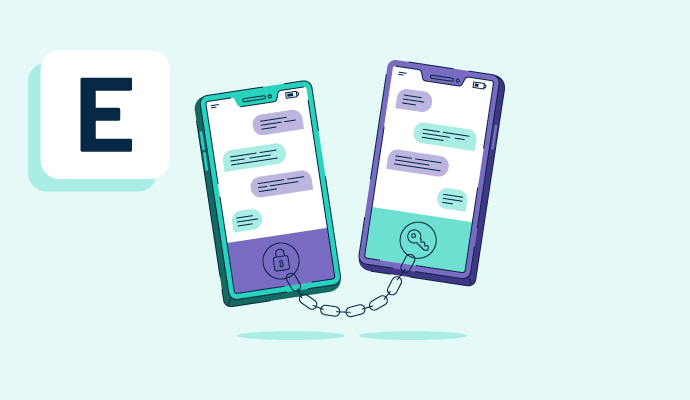What is end-to-end encryption?
End-to-end encryption (E2EE) is a popular, secure communication method that prevents unintended third parties from accessing data while it’s being transferred from one endpoint to another. Data is encrypted on the sender’s device, and only the intended recipient can decrypt and access it upon receiving it.
E2EE protects private and sensitive information and is necessary to protect financial, medical, and business documents.
Many businesses use encryption software to protect their data as it travels from one device to another and reduce liability in situations of accidental exposure. Encryption software converts standard data into scrambled data that is unusable to unintended parties while it travels across devices.
How does end-to-end encryption work?
With end-to-end encryption, the sender and intended recipient are the only people who can access the data. E2EE occurs at the device level.
Data is encrypted before it leaves the starting device, typically a phone or computer. A public key encrypts the data. It can only be decrypted by a private key at the end destination by the intended recipient. When the data is in transit, it’s scrambled into ciphertext and appears to be a series of random characters. The intended recipient can decrypt the message or data into plaintext upon receipt.
For example, Joe wants to send a private message to Luke. Luke has a public key and a private key. He can share his public key with anyone but keeps his private key secure so that he is the only one who can access it.
Joe uses Luke’s public key to encrypt his message, which reads, “Hi Luke, this is Joe. My address is 123 Blossom St. I’ll see you soon!” The note gets turned into ciphertext – or random characters.
Joe sends the encrypted message over the public internet, passing through multiple servers along the way. The ciphertext can’t be decoded on any servers it passes through, so no one can read the message. Once the message arrives in Luke’s inbox, he can decrypt the message with his private key, view the address, and head to Joe’s house.
What does end-to-end encryption protect against?
E2EE is a valuable encryption method; however, it doesn’t protect against every threat. There are two main threats E2EE protects against, including:
- Unwarranted viewing of data: E2EE ensures only the sender and intended recipient can read the contents of a message or files. This protects the data during transit from prying eyes as the data can’t be decrypted by anyone other than the sender and recipient.
- Tampering of data: Since messages are encrypted, malicious actors can’t tamper with or alter them. The integrity of the data is preserved as it transfers from device to device.
Benefits of end-to-end encryption
End-to-end encryption offers a high level of data privacy. Additional benefits of E2EE include:
- Enhanced security during transit: Since E2EE uses public key cryptography and private keys on the receiving devices, the only people who can decrypt the messages are the intended recipients. The data is fully protected during transit from the start to the endpoint. This is particularly important for businesses handling highly sensitive, confidential, and legally protected data.
- Reduced risk of data leaks: Unintended parties can’t access and steal data in transit since they don’t have the key to decrypt it. The integrity of the data and messages is maintained when using E2EE.
- Data is protected at the device level: Some other forms of encryption prioritize encrypting data at the server level. While server-level protection has advantages and disadvantages, if a malicious actor accesses the server, they can decrypt data and information and steal the information they want. It’s more difficult for hackers to perform device-level attacks.
Drawbacks of end-to-end encryption
Even though E2EE is a great option for protecting and securing data while in transit, this encryption method also has some potential drawbacks. Shortcomings of this encryption method include the following:
- Possible lack of endpoint security: While end-to-end encryption guarantees data protection while in transit, it can’t guarantee the same safety once it hits the endpoint device. Endpoint devices could have security issues or end up in the wrong hands. Once the data is decrypted on the receiving device, the receiver could share it with unintended recipients.
- Law enforcement access concerns: One argument against E2EE is that it protects data so well that it can negatively impact law enforcement investigations. With E2EE, law enforcement and intelligence officers cannot access encrypted evidence. They can only obtain the information they seek from the start and endpoint devices.
- Ability to see records of message transfers: End-to-end encryption jumbles data while in transit; however, it does not hide the fact that data is being transferred. It’s possible to see when a sender sends encrypted information and who they sent it to.
End-to-end encryption uses public and private keys. Learn more about public key encryption and how it helps ensure data integrity.

Alyssa Towns
Alyssa Towns works in communications and change management and is a freelance writer for G2. She mainly writes SaaS, productivity, and career-adjacent content. In her spare time, Alyssa is either enjoying a new restaurant with her husband, playing with her Bengal cats Yeti and Yowie, adventuring outdoors, or reading a book from her TBR list.

